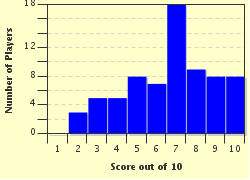Quiz Answer Key and Fun Facts
1. The stat BABIP tracks how many of a batter's hit balls in play end up as hits. What does BABIP stand for?
2. Pitching sabermetric WHIP stands for Wins, Hits, and Innings Pitched. The stat shows how many baserunners a pitcher allows. What is the relation between the three components of WHIP?
3. OPS is a stat that adds slugging percentage and which other stat to determine how often a player gets on base, and how well he hits?
4. Sabermetrics wRC and WRC+ try to determine how many ______ a player was worth to his team?
5. Field Independent Pitching or FIP is a stat that determines a pitcher's what if every team's defense was the same quality, average?
6. This sabermetric has become the main judgmental stat on how good a player is, and attempts to sum up all his contributions to his team, based on wins. What is the acronym used for it?
7. Because no ballpark in the MLB is the same, many sabermetric stats are adjusted so that all players can be treated fairly. Which of these ballparks is considered a hitter's park?
8. The stat HR/FB means Home Runs per Fast Ball - means how many home runs a player hits on fastballs.
9. These sabermetric looks at how many games a team should of won based on the runs scored, and allowed. The calculation is runs scored squared and divided by runs scored squared plus runs allowed squared. Which stat is this?
10. In the 2011 movie "Moneyball", who does Brad Pitt play, as he attempts to build the Oakland A's based on sabermetrics?
Source: Author
George95
This quiz was reviewed by FunTrivia editor
gtho4 before going online.
Any errors found in FunTrivia content are routinely corrected through our feedback system.

